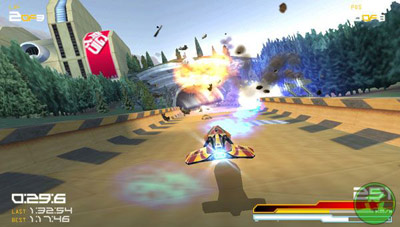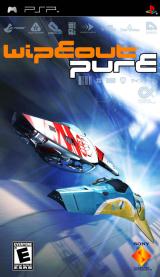Studio Liverpool, the SCEE development house responsible for Fusion, has returned to make a new name for itself with WipEout Pure. While the former was an attempt to broaden the scope of the franchise's gameplay, many of the systems introduced in Wipeout Fusion were obtuse and didn't positively affect the experience. For the follow-up, the developer has wisely snipped and trimmed off the elements that were ineffective and accentuated many of the traits that gamers adored from the series' earlier releases. The result is an extremely polished and playable futuristic racer that should thrill newcomers and absolutely destroy fans that have been itching for a more fulfilling, current-gen follow-up to their beloved series. If you fancy anti-gravity weapon-based racing, this one is most definitely for you.
Distilling the Essence of a Modern Classic
Pure's most notable achievement -- and the area in which Fusion was most lacking -- is it homogenous presentation. From the moment the PSP is booted to the second the system hits the coffee table with an empty battery, players of Pure will be confronted with an aural and visual experience that is as cohesive and well-crafted as any video game or feature film. Its menus, loading screens, and even the introductory cinematic are simple, elegant, and cutting edge. When players enter a race for the first time, the quality of the HUD and the beauty of the racing environment is instantly obvious. Even the stats screen is an essential element of the game's stunning presentation; in addition to listing tons or pertinent information, such as the number of gold medals that have been gathered and number of laps raced, it also includes an entry that indicates the exact amount of time that has been spent staring at the stats page. How's that for a laugh?

All of Pure's courses feature rich scenery such as this.
Even while playing WipEout Pure, it's difficult to believe the legitimacy of the image being displayed on-screen as the game tends to look more presentable than even its PlayStation 2 predecessor. Each of the game's eight new circuits is truly incredible to behold. The racing surfaces in city courses, such as Modesto Heights, Chenghou Project, and Sinucit, are set amid looming towers and other gigantic urban structures. But the beauty is in the minute details that adorn the tracks. Small figures watch the ships pass while standing underneath video billboards that appear to actually emit light thanks to a lovely bloom effect. In fact, it's almost a shame that the ships move as fast as they do; scenery as lovely as what's presented in WipEout Pure deserves more than a passing glance from the seat of a racing craft.





 Outstanding!
Outstanding!


